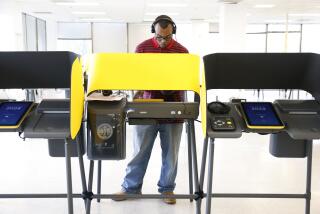Californy power
My mother, a child of the San Bernardino County city of Redlands, has always been fond of reciting an old country-song verse favored by her Oklahoma forebears.
Dear Okie,
if you see Arkie,
tell ‘im Tex’s got a job for him
out in Californy.
Within the rhyme lies part of the answer to a riddle that has caused head scratching in Hollywood and other elite opinion-making precincts of our state: How did Sen. Barack Obama lose the state so badly, despite such a visible, noisy surge of support?
In the days leading up to the election, wildly inaccurate polls and media reports that fixated on Obama’s celebrity endorsements left the strong impression that he would come close and perhaps pull out a from-behind victory. The coverage made Obama sound like the hot club on Melrose.
Television dwelled heavily on the tableau of an Obama rally at UCLA, attended by Caroline Kennedy, Oprah Winfrey and Maria Shriver, at which the first lady of California declared, “If Barack Obama were a state, he’d be California.” In a column that appeared the day before the primary, the New York Times editorial page editor called it one of the best political rallies ever, and declared that Obama’s campaign “seemed to have a monopoly on what is hip, young and glamorous in California.”
Besides the fact that the three celebrity women at the UCLA rally don’t qualify as young in a state as young as California, such analysis suffered from a common cultural, class and geographic bias about the state. And thus the story was missed. Obama, for all the interest he generated in wealthy coastal precincts, was failing in a frantic effort to gain traction in the California heartland: the Inland Empire counties of San Bernardino and Riverside, and the Central Valley stalwarts, Fresno and Kern counties.
There lies a different Democratic California, less known to outsiders than the gilded coast but no less important. The inland counties together constitute the fastest-growing parts of the state.
Riverside and San Bernardino counties, both media backwaters, boast more than 2 million residents each. This is the unofficial capital of the working class. The poverty rates in those counties closely reflect that of the state, but there are fewer rich people. Housing prices are about one-third lower there than the state average. Incomes are well below the state averages.
“Obama did the strongest in places like Santa Cruz County that are the exact opposite of the Central Valley and other inland areas,” said Dowell Myers, a demographer at USC. “The inland areas are full of people struggling to hold onto middle-class status. They’re not risk takers.”
It is by now accepted wisdom that California cleaves, politically, not north-south but east-west. We’re two states: a coastal blue state and an interior red state. The phrase that used to describe this phenomenon is “California, 50 miles inland, is Arkansas.” It is, politically speaking, Oklahoma and Tennessee too.
And while inland California is conservative and mostly Republican, there are millions of Democrats there as well. They cast their ballots in a way that closely resembles the voting patterns of the conservative Dust Bowl states whose job-seeking migrants settled the interior of Californy.
So take a look at the Democratic primary results from these three states:
* Oklahoma: Clinton 55%, Obama 31%.
* Tennessee: Clinton 54, Obama 40.
* In Arkansas, where Clinton was first lady,
she had a special hold on voters: 72-23.
Now compare them with
* Riverside County: Clinton 58.8%,
Obama, 34.3%
* San Bernardino: Clinton 59.1, Obama 34.6
* Kern County: Clinton 57.3, Obama 32.8
* Fresno County: Clinton 58.9, Obama 33.2.
Inland California was Clinton country, providing her the huge margins that paved the way for her 10-point victory statewide. Her performance in the interior demonstrated once again her national stranglehold on poor and working-class voters. In California, she won big majorities among people who make less than $50,000 a year, while Obama won majorities among those making $100,000 or more, according to exit polls.
Her much-touted Latino backing -- she won two-thirds of Latino Democratic voters statewide -- also gave her an inland boost. Riverside County is now 42% Latino, according to the most recent census figures. San Bernardino County is 46%.
For many, the results were unsurprising. “Hillary particularly attracts blue-collar voters,” says Carol Robb, a retired alternative high school teacher who serves as the county Democratic chair in San Bernardino. “We also have a very high percentage of Hispanic voters. When you put those two together, that’s my take on how you get the result you got.”
To their credit, Obama’s staffers understood California’s dynamics, and they did not surrender inland California. The campaign’s national field director, Cuauhtemoc “Temo” Figueroa, who grew up in Riverside County, spent much of the last several weeks in the Central Valley and the Inland Empire.
Obama had campaign offices throughout the region, including a high-visibility spot in downtown San Bernardino, but the candidate himself did not appear in inland California. Figueroa maintains that Obama’s ground operation made some gains that helped his delegate count, but the Illinois senator struggled in a region and a state where Clinton was better known.
“In California, our efforts fell a little short,” Figueroa told my Times colleague, Tom Hamburger. “It’s a state whose sheer size demanded more time from the candidate, which we did not have, for the Latino community or for many other communities and areas of the state -- they really did not get to know Barack.”
Perhaps with more time, Obama might have won over inland California. He has done well in other red states where he got to know voters. And a man with deep roots in Kansas probably has a few distant cousins within driving distance of San Bernardino. Such history still has a strong pull.
My great uncle Dale, who came to Redlands as a young man and still runs a family trucking business in Victorville, once welcomed me back to California from a stint on the East Coast by asking how I managed to survive in a place “where they don’t take kindly to Okie.”
It had been more than 60 years since he left our ancestral hometown of Okemah, Okla., and I’m barely half-Okie; a Pasadena kid, I’ve visited Okemah exactly twice in my life. But in that moment, we both heard the same song in our heads.
Joe Mathews is a staff writer for The Times.
More to Read
Start your day right
Sign up for Essential California for news, features and recommendations from the L.A. Times and beyond in your inbox six days a week.
You may occasionally receive promotional content from the Los Angeles Times.






